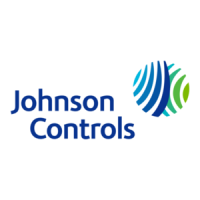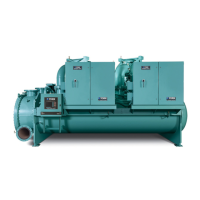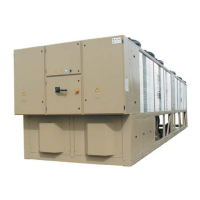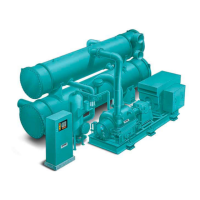JOHNSON CONTROLS
59
19
FORM 155.17-N1
ISSUE DATE: 4/1/2013
SECTION 19 – CHIMNEY DESIGN AND DRAFT THEORY
The ParaFlow
TM
Direct-Fired Chiller-Heater is
equipped with a forced draft burner capable of firing
on a variety of fuels, including natural gas and/or No.
2 oil and/or propane. As such, the unit will require a
properly de signed chimney sys tem to control draft and
discharge flue gases from the unit to the atmosphere.
DRAFT
The term draft is simply an indicator of how quickly
gases (products of combustion) leave the generator’s
firebox as compared to how quickly combustion air
and fuel are put in.
If flue gases are removed faster than fuel and air are
put in, the pressure within the firebox will be lower
than atmospheric pressure. In this case, there exists a
NEGATIVE DRAFT in the firebox.
In contrast, if the rate of fuel and air input is greater
than the rate of combustion product removal, there
will be a higher pressure in the firebox as compare to
atmospheric pressure. In this case, there exists a POSI-
TIVE DRAFT in the firebox.
Draft control serves two important functions
for the ParaFlow
TM
Direct Fired units:
1. It removes the combustion products for the living
or work space.
2. Minimizes excess draft, which pulls useful heat
out of the unit and lowers its efciency.
Draft depends on two important factors:
1. The temperature difference between the ue gas
and the outside air.
2. The height of the chimney.
TEMPERATURE DIFFERENCE
Chimney draft is the force created by the difference
in temperature between the flue gases and the outside
ambient air. The magnitude of this temperature differ-
ence is directly proportional to the draft created. Tem-
perature differences cause drafts be cause gases such as
air occupy different volumes at dif fer ent temperatures.
For example:
One cubic foot of air weights 0.0834 lbs. at 0°F
(17.8°C). This same cubic foot of air at 450°F
(232.2°C) weighs only 0.0422 lbs. The amount of mass
per specific volume is referred to as density. Density
decreases as temperature increases and lighter (lower
density) air rises while heavier (more dense) air sinks.
Heated combustion gases, being less dense than the
cool er outside air, rise and flow out the top of the
chimney and create a partial vacuum. This causes a
negative pressure at the chimney inlet that pulls in
more gas for venting. This pulling force is referred to
as chimney draft.
Because ParaFlow
TM
units are capable of operating in
both the heating and cooling modes, the outdoor air
tem per a tures will change significantly from the sum-
mer to the winter. These wide temperature swings
must be ac count ed for during burner start-up. The
larger the tem per a ture difference, the greater the draft.
Therefore, when the unit is operating during the colder
months, more draft will be produced. It is essential
that the chimney sys tem be designed using summer
ambient conditions so as to avoid undersizing the
draft system.
CHIMNEY HEIGHT
Chimney height is another major factor influencing
the intensity of the draft. Generally, the higher the
chimney, the higher the draft. Figure 28 on page 61
shows the relationship between stack height, tempera-
ture, and draft.
The combustion system for the ParaFlow
TM
Chiller-
Heat er is engineered to produce a positive gauge pres-
sure at the outlet of the high-temperature generator
(the unit is a positive forced draft appliance). The ex-
haust temperature at the outlet of the high-temperature
generator at full load condition will be around 400°F
gross temperature(204.4°C) +/- 50°F (23.6°C).

